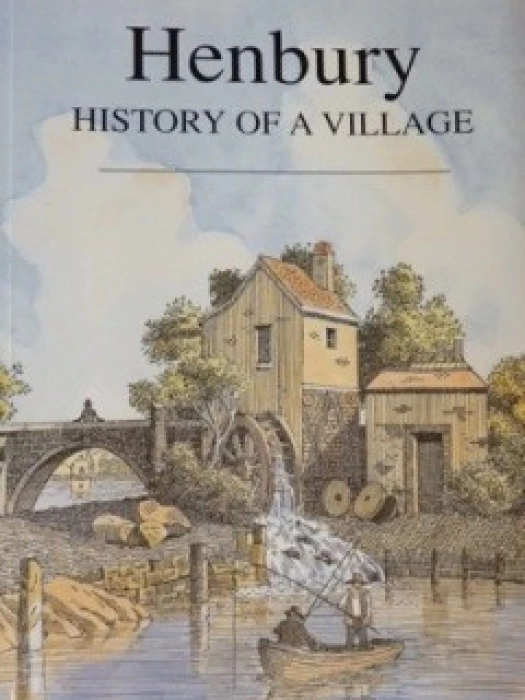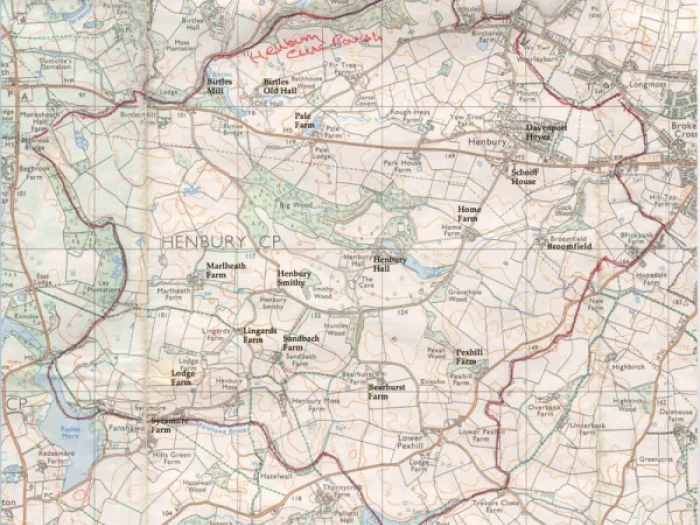The History of Henbury
Recent History......
Ancient History......
History of a Village
Book Cover: The Henbury Water Mill on Engine Pool
Design by W Geldart
This 226 page book was published March 2003 by The Henbury Society.
The book is available for purchase from the Henbury Society by contacting them via editor@henbury.org
Based on the information provided in this excellent book a pictorial description, with some explanatory notes, is provided to help the reader gain a better understanding of our historic past and to view those buildings of interest. The location of the buildings within the Parish are identified on our Parish Map .
Hameteberie is the name of the village as it was recorded in Domesday Book of 1086. In 1288 the name appears as Hendebiry, and except for small variations has not changed much for the last 700 years. It seems certain that Henbury was always a scattered farming community, and it is unlikely that the open field system of agriculture was ever practised here. The scattered nature of the settlement eventually gave rise to the establishment of hall, parkland, mill and possibly a chapel, all within the old Saxon boundaries.
From about 1350, and probably earlier, the Henbury Hall Estate has dominated the land holdings in Henbury. Henbury was probably not a manor in the full sense, but the Davenports, whose lordship extended from mediaeval times to the end of the 17th century, seem to have run it as though it were. For many centuries Henbury was a stable and increasingly prosperous farming community but, the 20th century, almost everything changed. Many farmhouses became private residences and many new houses were built north of the main Chelford Road.
Many local farms are of considerable antiquity: Sandbach, Marl Heath, Lingards, Lodge Farm, Pale Farm and Sycamore Farm all display timber frames and some show evidence of wattle and daub infilling. Pale Farm in particular, a beautiful black and white yeoman's house on Chelford Road dates back at least to the 15th century, possibly earlier.
There are a number of cottages too, some thatched, in the Fanshawe Lane area probably dating from medieval period. Moss Cottage was known to have a 1561 date stone, now concealed under render. Sandbach Farm bears a 1641 date, just before the Civil War. On Church Lane, Davenport Heyes carries the date 1733 on what was the stable, and High Tree, a cottage on Andertons Lane is dated 1765. The Church School on School Lane, was established by Thomas Marsland in 1845, not long after he took over Henbury Hall and estate in 1842. It occupied what had been a farmhouse, Hulmes Tenement, the classroom occupying what had been the shippon.
A small area around Henbury Moss contains a remarkable concentration of small farms. Seven – Bearhurst, Sandbach, Henbury Moss, Lodge, Lingards, Marl Heath and Henbury Smithy – are all within a radius of less than half a mile.
You may also be interested to view and read about other interesting buildings in the Parish of Henbury. Some noteworthy examples are Broomfield Farm, Bearhurst Farm and Home Farm. Birtles Mill, near to Birtles Old Hall is situated to the western part of the Parish, in close proximity to Pale Farm. Attractive cottages can be found at the southern boundary but, alas, several buildings have vanished having been demolished to be replaced by modern dwelling.
Having been stable for many centuries, the last 50 years have seen a major transformation in the village with the centre of population moving from the south to the north of the A537.
This short article is intended to provide a flavour of the historic background of the Henbury Parish and to provide some pictorial information of buildings of interest. This does not even scratch the surface of the wealth of information contained in the book.


